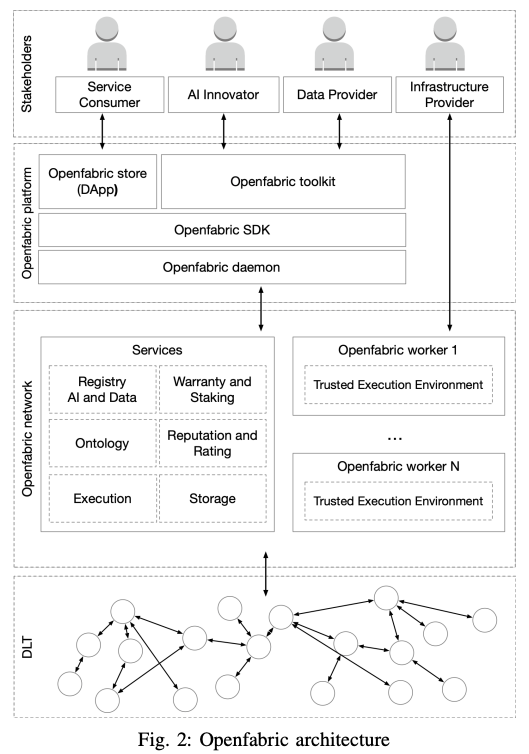Openfabric ecosystem
A. Architecture Overview
Openfabric is an ecosystem which harnesses the power of blockchain [30], distributed ontologies [31], advanced cryptography [32], and a trusted execution environment by developing a novel infrastructure that is capable of supporting the authentic AI revolution. Inspired by the primordial soup that stimulated the interaction between replicators [33], our system provides a consistent medium wherein AI agents can combine seamlessly to support increasingly more advanced features. Agents’ intercommunication is defined by ontological schemes. The evolutionary pressure [33] that controls AI agents progression is governed by a distributed secure rating mechanism [34]. Fig. 2 shows the overall architecture of Openfabric. The design is composed of several structural elements that provide an open, practical, scalable, and extensible system. The logical structure of the architecture implies several layers. At the top are the stakeholders interacting with the platform through specialized tools connected to the underlying network services operating on DLT (decentralized ledger technologies).

Fig. 2: Openfabric architecture
B. Stakeholders
Aiming to create a self-sufficient ecosystem, Openfabric envisions holistic interactions [35], [36] between four significant stakeholders:
- Service Consumer
- AI Innovator
- Data Provider
- Infrastructure Provider
The service consumer represents the end-user who needs to solve particular business problems to enrich their products or services with an extra layer of intelligence. According to the level of integration and expertise, the service consumer can utilize AI services via the Openfabric marketplace or the SDK. The platform simplifies the experience by eliminating the prerequisites of having technical skill or owning the hardware equipment required for running and training AI.
The AI innovators utilize their expertise to create elaborate and practical AI algorithms capable of solving complex business problems. The platform incentivizes the innovator to focus on delivering high-quality solutions and engaging in cooperation instead of competition, by reusing algorithms deployed by others to build ever-more intricate AI solutions.
The data providers ensure the vast amount of data required to train and test AI algorithms. Companies that possess consistent datasets can make a profit by licensing them on the platform to be used by the innovators and data providers.
The infrastructure providers supply the platform hardware capabilities required for running and training AIs. Solving challenging and complex problems requires a considerable amount of computing power that can only be achieved through the joint participation of multiple providers.
C. Openfabric Platform
The Openfabric platform includes the high-level system components; it abstracts the infrastructure complexity from the uppermost levels, facilitating the business use cases and integration with extension modules. The main components are:
- Openfabric store (DApp) - marketplace providing the end-user with access to platform functionalities;
- Openfabric toolkit - contains the collection of IDE extensions, CLI tools, libraries, frameworks, and development tools used by AI innovators.
- Openfabric SDK - provides programmatic access to the platform functionalities;
- Openfabric daemon - represents the client maintaining the connection to the network;
D. Openfabric Network
The network layer contains nodes implementing the core service and the execution environment. Operating on top of a federated P2P network, the Openfabric protocol provides core services by integrating modules which manage storage, execution, interoperability, rating, etc. The Openfabric workers are specialized nodes running on top of the Infrastructure providers’ hardware. At this level, the AI algorithms are being executed inside a secured environment.
E. Distributed Ledger Technology / Blockchain
The system replication, decentralization, and communication are ensured by the DLT layer. Representing the communication backbone of the system, a set of decentralized technologies is integrated, providing support for storage [37], [38], [39], state management [40], [41], resource allocation, etc. From a technical perspective, the platform should be agnostic to the DLT solution. With the use of blockchain, the inherited features of trust, security, and transparency are ensured. Maintaining the state of the ledger is secured by a consortium of companies, with each company running a set of peer nodes. Adding new members to this network requires complaining to the governance model parameters.
F. Decentralized Operating System (DOS)
Coordinating a set of services of such scale and complexity requires a novel approach towards the entire system architecture [42]. The fair and secure governance of the platform is enforced by a set of protocols and procedures. The network services, resources and processes are supervised by a decentralized / distributed operating system (DOS) [43], [44]. Composed of a trusted P2P [45] network of nodes, the DOS ensures the proper functioning of the system. As depicted in Fig. 3, the P2P network acts as a host for a virtualized multidimensional consensus mechanisms. Through the use of a dynamic consensus mechanism [46], the network operates numerous decisions in parallel required to run the DOS services. According to the importance of the resolution, degree of security, and impact, the number of nodes needed to reach consensus may vary.

Fig. 3: Openfabric operating system
Resembling the logical structure of a traditional OS, the nodes are organized into logical layers:
- Application layer - operates protocols intermediating the interaction between users and the system. This isolates the user from the implementation details, in conjunction with offering an improved user experience.
- Kernel layer - encapsulates protocols and procedures for searching, rating, executing, and registering of AIs, datasets, and infrastructure.
- Resource layer - adapts the underlying technological dependencies, such as IPFS [47], blockchain, and operational smart-contracts used to allocate, register, and rate AIs and infrastructure providers.
